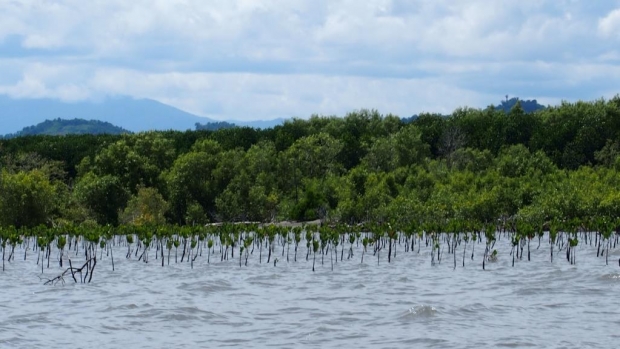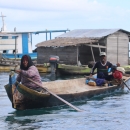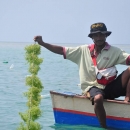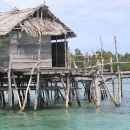Grants :: Small Grant Facilities :: Sustainable and Effective Coastal Resources Management to Improve Community Well-Being through Indonesia Coral Action Network (I-CAN)
Sustainable and Effective Coastal Resources Management to Improve Community Well-Being through Indonesia Coral Action Network (I-CAN)

Mangrove ecosystem at Lemito subdistrict, Lemito subdistrict, Pohuwato Regency, Gorontalo © MFF IUCN
Objectives
To improve the effectiveness and sustainability of coastal management (mangrove and coral reef ecosystem) and to improve coastal-dependent community livelihood
Background
Lemito sub-district situated in Tomini Bay has the richest marine biodiversity compared to any other regions in the coral triangle. Therefore, this area is considered to be the heart of coral triangle and "center of diversity." Besides the high diversity of coral reefs, the reef fish in Tomini Bay are also enormously diverse. Moreover, Tomini Bay is the home for several endemic species such as Banggai Cardinal Fish (BCF) and provides migratory route for some species with high economic value. Waters of Lemito sub district are ideal place for mariculture, one of which is seaweed culture. Mangrove forests stretching along the coastal areas can also be found in Lemito District.
However, some recent reports suggest that mangrove cover in Lemito District has been significantly reduced due to destructive fishing practices and land conversion. Local communities explained that the destructive fishing practices have been started since 1990s that not only severely damage coral reefs but also also significantly reduce fish populations. In addition, land conversion into fish or shrimp ponds leads to loss of mangroves over years.
The lack of regulations and management measures as well as poor law enforcement in waters and coastal areas of Lemito indicates the need for local communities to actively engage in monitoring the utilization of marine, coastal and other natural resources. Therefore, capacity building program is crucial for the local communities to ensure their involvement in monitoring program, and collaboration between local communities and government is essential for sustainable management of resources in this region.
Target beneficiaries
Residents of Lemito subdistrict.
Outputs
- Fisher group received training on monitoring and reporting coastal resources utilization;
- 10 fishermen received training on seaweed farming by applying floating net;
- 10 units of seaweed culture were established. However, considerable amount of seaweed could only be extracted from 3 farming units (virus outbreaks occurred in 7 other units).
Accomplishments and challenges
- . One community group consisted of 14 members was established;
- Training on simple data collection participated by community groups and aimed to provide simple methodology in collecting data on destructive fishing practices was conducted;
- 2-day training on sea grass cultivation and post-harvest management had been carried out, facilitated by District’s Marine and Fisheries Office;
- A community group was provided with a unit of equipment for sea grass cultivation, including installment of floated culture platform and maintenance facilities, in close collaboration with local Marine and Fisheries Office. Unfortunately the harvest was not very successful, probably due to the poor water condition that led to virus outbreaks;
- Other activities included:
- Collection of simple data. The collection of simple data on coastal and sea resources utilization had been proven to be useful to be adopted by local government to overcome the on-going destruction of the coastal/sea ecosystem. This needed to be supported with the development of productive economy, such as sea grass cultivation. Collaboration between village government and Marine and Fisheries Office wass very much required to overcome the destructive fishing activities in Lemito sea/coastal areas;
- Regular two-weekly updated simple data on the coastal resources condition (coral reefs and mangrove) provided by local communities. Data were collected from community group members, informal community leaders, village government and District Fishery Office. In addition, a ground truth assessment on mangrove ecosystem in Lemito area had been finalized during this reporting period. The availability of these updated data was helpful in improving community understanding on the economic and ecological benefits of the three well-known ecosystems: mangrove, sea grass and coral reef. In addition, these efforts increased motivation and self-belonging of local communities to protect these ecosystems.
- Regular coordination with village government, district’s Marine and Fisheries Office and Head of District Office carried out, especially on the reporting of destructive fishing events collected by local community group.
Contributions to cross-cutting themes
- Knowledge management and communications
Publication materials developed and disseminated during the project period include: videos (displayed on national television channels), posters, banners, backdrop, articles, press release, etc.
Lessons Learned
- Overall project objective and measurable results as well as means of verification should be well established at the beginning of project implementation. Moreover, the overall project objective should meet with MFF's ultimate goal
is to promote an integrated ocean-wide approach to coastal management and to building the resilience of ecosystem-dependent coastal communities. - See more at: https://www.mangrovesforthefuture.org/who-we-are/about/who-we-are/#sthash.vnqYr1E9.dpuf.
Country
Location
Lemito subdistrict, Pohuwato Regency, Gorontalo
Topic
Duration
6th May 2014 to 5th May 2015
MFF Grant Amount
IDR 192,950,000
Implementing Partner
Destructive Fishing Watch Indonesia (DFW)
SME Tower Building, Level 10.
Jl. Jend. Gatot Subroto Kav. 94.
Jakarta Selatan- Indonesia – 12780.
Contact person: Mr AY Fauzan, Programmme Coordinator
Mobile: +6281342616392
Email address: andifauzan2012@gmail.com


